The images of new Rs 2000 and Rs 500 were released by RBI on their twitter account @RBI. This article covers New Rs 500 and Rs 2000 notes. What are the salient features of Rs 500 and Rs 2000 notes?Compares old and new 500 Rs note. It talks about technology for tracing the chips and goes down memory lane showing old 1000,5000 and 10,000 rupee notes and when different notes and features were introduced in our Indian currency.
Table of Contents
New Rs 500 and Rs 2000 notes
After Prime Minister Narendra Modi announced trashing of old Rs 500 and Rs 1000 bank notes to curb black money, RBI has released the details of newly minted Rs 500 and Rs 2000 bank notes. The new Rs 500 note is completely different from the old note while the new Rs 2000 note has 17 major features to make it stand out. Our article Currency Management: How does Indian Notes and Coins reach People talks about where are Indian rupee Notes and coins printed? What are currency chests, Cost of Printing Indian Rupee Notes and Cost of Replacing the Rs 500 and Rs 1000 notes
The rumour of the inclusion of a tracking chip in the notes went viral on social media and WhatsApp hours after Prime Minister Narendra Modi announced the demonetisation plan. The Rs. 2,000 notes that will enter into circulation from November 10, 2016 will not have any electronic chip, the Reserve Bank of India clarified on Wednesday.
New Rs 2000 Note
From RBI Released information on Rs 2000 note, base colour is magenta, Dimension of the banknote will be 66mm×166mm. There is a difference in the shades of colour on the Rs 2,000 notes
The Reserve Bank of India will issue ₹2,000 denomination banknotes in the Mahatma Gandhi (New) Series, without the inset letter, bearing signature of Urjit Patel, governor, Reserve Bank of India, and the year of printing “2016” printed on the reverse of the banknote. The new denomination has Motif of Mangalyaan on the reverse, depicting the country’s first venture into the interplanetary space. Salient feature of Rs 2000 note front and back are as follows.
- 1. See through register with denominational numeral 2000.
- 2. Latent image with denominational numeral 2000.
- 3. Denominational numeral २००० in Devnagari.
- 4. Portrait of Mahatma Gandhi at the centre.
- 5. Micro letters ‘RBI’ and ‘2000’ on the left side of the banknote.
- 6. Windowed security thread with inscriptions ‘भारत’, RBI and 2000 on banknotes with colour shift. Colour of the thread changes from green to blue when the note is tilted.
- 7. Guarantee Clause, Governor’s signature with Promise Clause and RBI emblem towards right.
- 8. Mahatma Gandhi portrait and electrotype (2000) watermarks.
- 9. Number panel with numerals growing from small to big on the top left side and bottom right side.
- 10. Denominational numeral with Rupee Symbol, ₹2000 in colour changing ink (green to blue) on bottom right.
- 10. Ashoka Pillar emblem on the right,
For visually impaired
- Intaglio or raised printing of Mahatma Gandhi portrait, Ashoka Pillar emblem, bleed lines and identity mark.
- 12. Horizontal rectangle with ₹2000 in raised print on the right.
- 13. Seven angular bleed lines on left and right side in raised print.
Reverse (Back)
- 14. Year of printing of the note on the left.
- 15. Swachh Bharat logo with slogan.
- 16. Language panel towards the centre.
- 17. Motif of Mangalyaan.
New 500 Rupee note
The RBI will issue ₹ 500 denomination banknotes in Mahatma Gandhi (New) Series with inset letter ‘E’ in both the number panels. The note will have the signature of Governor Dr Urjit R Patel and will bear the year of printing ‘2016’ and Swachh Bharat Logo printed on the reverse of the bank note. The size of the new note is 63 mm x 150 mm. The colour of the notes is stone grey and the predominant new theme is Indian heritage site – Red Fort. The new Rs 500 notes are different from the present series in colour, size, theme, location of security features and design elements.
On The Front side of new 500 rupee Note
- 1 See through register in 500 denomination numeral
- 2. Denomination numeral’s latent image
- 3 Denomination numeral in Devanagari lipi can be found
- 4 Mahatma Gandhi’s portrait orientation and relative position is changed
- 5 Windowed security thread changes colour from green to blue when you tilt the note
- 6 Guarantee clause, Governor’s signature with premium clause and RBI emblem tilted towards right
- 7 Electrotype and Portrait watermarks
- 8 Number panel with numerals growing from small to large on top left and bottom right sides
- 9 On the bottom right denomination numerals with rupee symbol in colour changing ink from green to right
- 10 Ashoka pillar emblem can be seen on the right side
For Visually Impaired:
Mahatma Gandhi portrait, Ashoka Pillar emblem and identification mark in raised print
- 11 500 in raised print on the right with circle
- 12 On the left and right five bleed lines in raised print
On The back side:
- 13 Printed year on the left side
- 14 Logo of Swatch Bharat with slogan
- 15 Language panel towards centre
- 16 Red fort image with Indian flag
- 17 Numeral of denomination in Devanagari on the right
Variations of Rs 500 notes
There is a more than visible shadow of Gandhi’s face, besides alignment issues with the national emblem on the note and even serial numbers .The RBI governor’s promise is much closer to the security thread in one variant than the other .
Difference between old 500 Rupee Note and new 500 Rupee Note
The following image shows both new and old 500 Rupees note
Languages on Bank Note
Rumors spread that there is a printing error in mentioning Rs.2000 in HINDI. They pointed that instead of printing as “DO HAZAR”, they wrongly printed as “DON HAZAR”, as shown im image below. On left hand side of note is 2000 Rs in Hindi. Along with that note also carries value mentioned in 15 regional languages. The DON HAZAR is related to regional languages of Konkani and Marathi.
Each banknote has its amount written in 17 languages. On the obverse or front, the denomination is written in English and Hindi. On the reverse is a language panel which displays the denomination of the note in 15 of the 22 official languages of India. The languages are displayed in alphabetical order. Languages included on the panel are
Assamese, Bengali, Gujarati, Kannada, Kashmiri, Konkani, Malayalam,Marathi, Nepali, Oriya, Punjabi, Sanskrit, Tamil, Telugu and Urdu.
Tracking chip in new notes
Banknotes already include such security features as holograms,watermarks,special threads, microprinting, special inks etc. WhatsApp had messages about new 500 Rs and new 2000 Rs notes and how the notes would be embedded with NGC (‘Nano GPS Chip’) and therefore could be easily traced, via satellite, even if they were buried deep underground.Technically, NGC technology can be used in currency notes, as thinned down chips were reportedly developed by a team at North Dakota State University in 2013.
This isn’t the first time there has been speculation about NGC/RFID tracking on currency notes worldwide. In the early years of the century, there were several media reports on intense speculation that the European Central Bank was contemplating adding RFID tags to high denomination banknotes of €200 and €500, both of which are not commonly circulated. As late as 2012, there were reports of Saudi Arabia mulling a similar option to curb counterfeit currency.
It costs the government Rs 3 to print a Rs 1,000 note. RFID technology would potentially increase the cost per note significantly. And then would the signal be strong enough to be picked up by satellite, as claimed by the WhatsApp forward? RFID tags needs readers in close proximity, so readers could be installed at public places to catch the ‘sought-after’ notes, but the forward talks of NGC, which is satellite-based
Down the memory lane
The highest denomination note ever printed by the Reserve Bank of India was the Rs. 10,000 note in 1938 and again in 1954. But these notes were demonetised in January 1946 and again in January 1978. However, this is the first time that Rs. 2,000 currency note is being introduced.
Rs. 1,000 and Rs. 10,000 bank notes were in circulation prior to January 1946. Higher denomination banknotes of Rs. 1,000, Rs. 5,000 and Rs. 10,000 were reintroduced in 1954 and all of them were demonetised in January 1978.
The Rs. 1,000 note made a comeback in November 2000. Rs. 500 note came into circulation in October 1987. The move was then justified as attempt to contain the volume of banknotes in circulation due to inflation.
- Bank notes in Ashoka Pillar watermark series in Rs. 10 denomination were issued between 1967 and 1992, Rs. 20 in 1972 and 1975, Rs. 50 in 1975 and 1981 and Rs. 100 between 1967-1979.
The banknotes issued during this period contained the symbols representing science and technology, progress and orientation to Indian art forms. - In the year 1980, the legend Satyameva Jayate — ‘truth alone shall prevail’ — was incorporated under the national emblem for the first time.
- In October 1987, Rs. 500 banknote was introduced with the portrait of Mahatma Gandhi and Ashoka Pillar watermark. Mahatma Gandhi (MG) series banknotes – 1996 were issued in the denominations of Rs. 5, (introduced in November 2001), Rs. 10 (June 1996), Rs. 20 (August 2001), Rs. 50 (March 1997), Rs. 100 (June 1996), Rs. 500 (October 1997) and Rs. 1,000 (November 2000).
- The Mahatma Gandhi Series – 2005 bank notes were issued in the denomination of Rs. 10, Rs. 20, Rs. 50, Rs. 100, Rs. 500 and Rs. 1,000 and contained some additional/new security features as compared to the 1996 MG series.
- The Rs. 50 and Rs. 100 banknotes were issued in August 2005, followed by Rs. 500 and Rs. 1,000 denominations in October 2005 and Rs. 10 and Rs. 20 in April 2006 and August 2006, respectively.
Related articles:
- Ban on 500 and 1000 rupee notes fight against corruption, PM speech
- Currency Management: How does Indian Notes and Coins reach People
- Withdrawal of Pre 2005 Indian Currency Notes
- Indian Currency
- Currency
What do you think of new Rs 500 and Rs 2000 note?
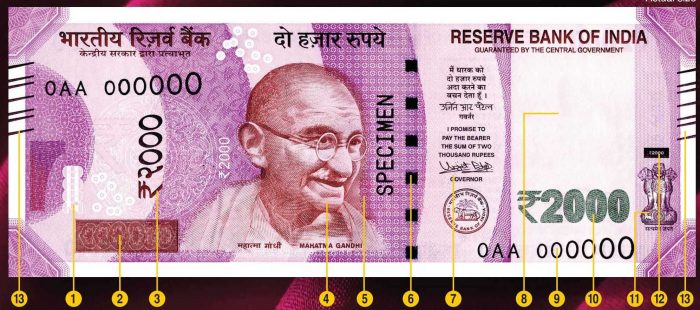
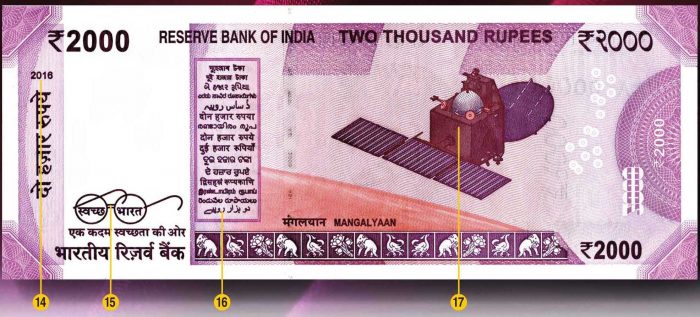
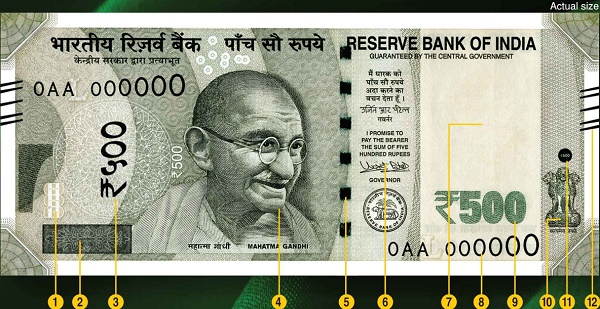
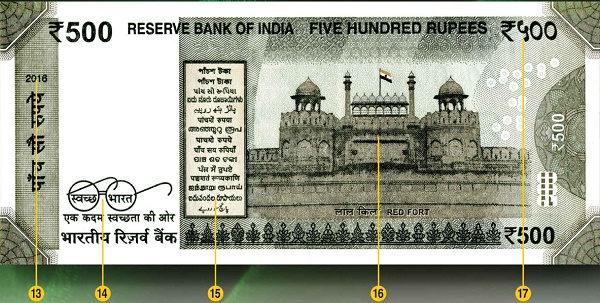
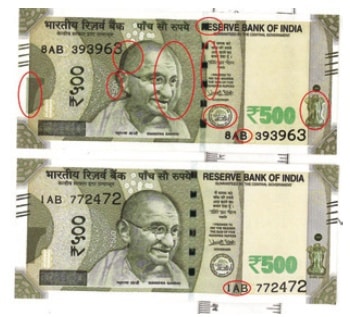
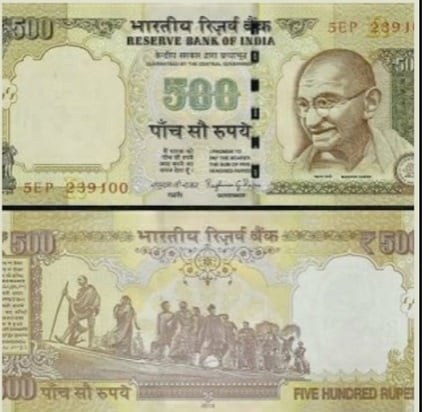
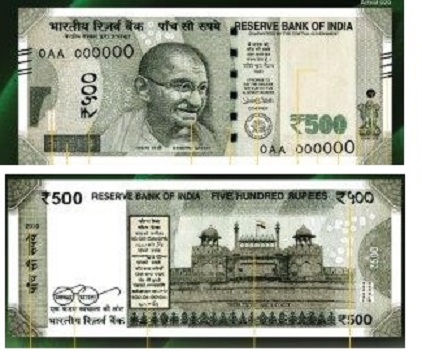

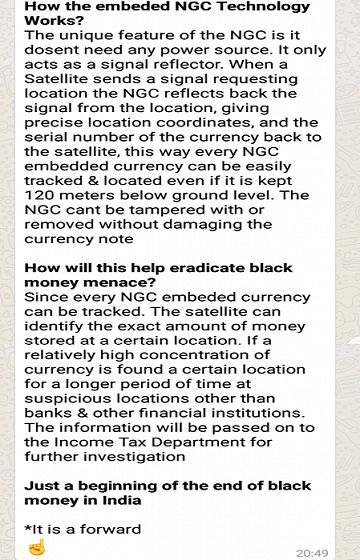





sir what those lines represents at the left and right most position.
Note printing district name
now, election campaigning will be a treat to watch 😀
I’m skeptic about the bribes though.
super idea to change the notes.. swatch barath….
This is what everybody is looking for.. thanks a lot for sharing.. Keep posting more articles like these..